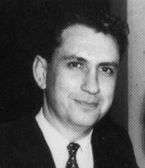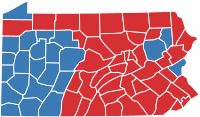United States Senate election in Pennsylvania, 1980
| | |||||||||||||||||||||||
| |||||||||||||||||||||||
| |||||||||||||||||||||||
|
| |||||||||||||||||||||||
| County results | |||||||||||||||||||||||
| |||||||||||||||||||||||
The 1980 United States Senate election in Pennsylvania was held on November 4, 1980. Incumbent Republican U.S. Senator Richard Schweiker decided to retire, instead of seeking a third term. Republican nominee Arlen Specter won the open seat, defeating Democratic nominee Peter F. Flaherty.
Major candidates
Democratic
- Pete Flaherty, former Mayor of Pittsburgh
- Joseph Rhodes, Jr., Pennsylvania State Representative
- Edward Mezvinsky, former U.S. Representative
- H. Craig Lewis, Pennsylvania State Senator
- Peter J. Liacouras, Dean of Temple University Law School
Republican
- Arlen Specter, former District Attorney of Philadelphia
- Bud Haabestad, Delaware County Councilman
- Edward L. Howard, Pennsylvania State Senator
Campaign
Arlen Specter, formerly a member of the Democratic party, had served as legal counsel to the Warren Commission, which investigated the 1963 assassination of President John F. Kennedy, after which he became District Attorney of Philadelphia. After he was defeated in a 1967 run for Mayor of Philadelphia, Specter was defeated in his bid for a third term as district attorney. He had run in the Republican primary in the 1976 Senate election, but was defeated by John Heinz and also ran in the 1978 gubernatorial election, but was defeated by Dick Thornburgh in the primary. Shortly after Specter opened a law practice in Atlantic City, New Jersey, incumbent Republican U.S. Senator Richard Schweiker unexpectedly announced his decision not to seek re-election to his seat. Specter, believing his reputation as a political moderate would help him in the general election, decided to run. In the Republican primary, Specter faced state senator Edward Howard, as well as Delaware County councilman Bud Haabestad, who was endorsed by Schweiker, then-governor Thornburgh and John Heinz. Specter ultimately defeated Haabestad, his most prominent challenger, by approximately 37,000 votes.[1]
In the Democratic primary, former Pittsburgh mayor Peter Flaherty contended with State Representative Joseph Rhodes, Jr., former U.S. Representative Edward Mezvinsky, State Senator H. Craig Lewis and Dean of Temple University Law School Peter J. Liacouras. Flaherty's name recognition enabled him to defeat his primary opponents, winning every county and thus winning the Democratic nomination.[1]
Flaherty employed a general election strategy he had used in two previous statewide office campaigns: win by a wide margin in the southwestern part of the state and narrowly win Philadelphia. He also hoped to carry several swing towns on account of his support from several labor unions. Specter hoped to carry his home town of Philadelphia, despite the Democrats' 7-2 voter registration advantage there. To this end, Specter sought endorsements among city Democratic leadership, including future mayor John F. Street. Specter hoped that, with wins in suburban areas and the heavily Republican central portion of the state in addition to winning Philadelphia, he would be able to win the election. Specter distanced himself from Governor Dick Thornburgh, who had become unpopular in some demographics due to his proposals to decrease welfare program spending.[1]
In the end, Specter defeated Flaherty by approximately 108,000 votes, carrying Philadelphia and its suburbs as well as the central and northeastern portions of the state. Flaherty performed strongest in the western portion of the state, including Cambria, Clarion, Erie and Mercer counties.[1]
Results
| Party | Candidate | Votes | % | ± | |
|---|---|---|---|---|---|
| Republican | Arlen Specter | 2,230,404 | 50.48 | ||
| Democratic | Peter F. Flaherty | 2,122,391 | 48.04 | ||
| Socialist Workers | Linda Mohrbacher | 27,229 | 0.62 | ||
| Libertarian | David K. Walter | 18,595 | 0.42 | ||
| Consumer | Lee Frissell | 16,089 | 0.36 | ||
| Communist | Frank Kinces | 3,334 | 0.08 | ||
| Majority | 108,013 | 2.44 | |||
| Turnout | 4,418,042 | ||||
| Republican hold | Swing | ||||
References
- 1 2 3 4 Kennedy, John J. (2006). Pennsylvania elections : statewide contests from 1950-2004. Lanham, Md.: University Press of America. pp. 61—63. ISBN 0761832793.
- ↑ "Statistics of the Congressional and Presidential Election of November 4, 1980" (PDF). Office of the Clerk of the U.S. House. Retrieved 8 July 2014.


